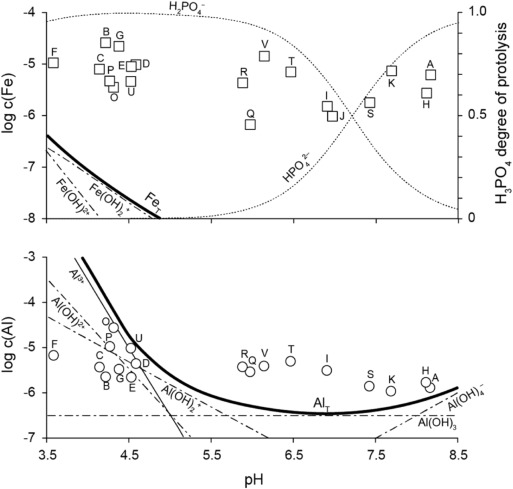 The photochemical transformation of terrestrial dissolved organic carbon (DOC) in surface waters exposed to UV radiation causes the precipitation of metal (Al and Fe) bearing complexes with high phosphorus sorption capacities. To better elucidate this process, a series of laboratory experiments was performed with stream and river waters with pH range from 3.5 to 8.2 and concentrations of dissolved reactive phosphorus from 2 to 142 μg L−1. Samples were filtered (0.4 μm) and UV (350 nm) irradiated for 24 h at 68 W m−2, i.e. under conditions equivalent to ∼2 summer days of natural solar radiation. Irradiated samples and dark controls were then spiked with 33P-phosphate and the kinetics of P adsorption on freshly formed particles was determined after separation by ultracentrifugation. Up to 68 % of the added P was removed from the solution within 48 h of the spike. The P sorption was pH dependent, with the maximum sorption ability at pHs of 6–7. We hypothesize that this process can importantly contribute to the immobilization and lower bioavailability of P in the inlet areas of (especially circum-neutral) lakes due to the intensive photochemical degradation of allochthonous DOC-metal complexes.
The photochemical transformation of terrestrial dissolved organic carbon (DOC) in surface waters exposed to UV radiation causes the precipitation of metal (Al and Fe) bearing complexes with high phosphorus sorption capacities. To better elucidate this process, a series of laboratory experiments was performed with stream and river waters with pH range from 3.5 to 8.2 and concentrations of dissolved reactive phosphorus from 2 to 142 μg L−1. Samples were filtered (0.4 μm) and UV (350 nm) irradiated for 24 h at 68 W m−2, i.e. under conditions equivalent to ∼2 summer days of natural solar radiation. Irradiated samples and dark controls were then spiked with 33P-phosphate and the kinetics of P adsorption on freshly formed particles was determined after separation by ultracentrifugation. Up to 68 % of the added P was removed from the solution within 48 h of the spike. The P sorption was pH dependent, with the maximum sorption ability at pHs of 6–7. We hypothesize that this process can importantly contribute to the immobilization and lower bioavailability of P in the inlet areas of (especially circum-neutral) lakes due to the intensive photochemical degradation of allochthonous DOC-metal complexes.
Keywords: photodegradation, DOM, phosphorus, aluminium, iron
